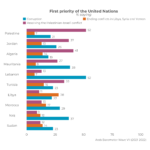Elevating the voices of Arab citizens is at the forefront of what we do at Arab Barometer. And, during uncertain times, listening to the needs and concerns of ordinary people is extremely important. As such, Arab Barometer research network recently completed a unique survey that captures the sentiments of Arab publics amid the unprecedented times of the COVID-19 pandemic. However, conducting a public opinion survey during the global health crisis came with its own set of challenges.
I spoke with Dr. Michael Robbins, the director of Arab Barometer, to learn how the research team faced the COVID-19 disruptions and how they adapted to the new reality of conducting surveys in the time of Corona.
Aseel Alayli: Why did the Arab Barometer decide to suspend the face to face survey fieldwork that was scheduled for the summer of 2020? Will you resume face to face surveys in the future?
Michael Robbins: At the outbreak of the COVID-19 pandemic, Arab Barometer suspended face-to-face surveys to protect the health and safety of our fieldworkers and survey respondents. At a time when it is safe and there is not undue risk to fieldworkers or respondents, we plan to resume conducting face-to-face surveys.
Alayli: Why did the Arab Barometer decide to conduct a phone survey instead of a face-to-face survey?
Robbins: Arab Barometer decided to conduct a phone survey as the next best option to a face-to-face survey in the midst of the COVID-19 pandemic. We coordinated with our regional partners to ensure phone surveys could be done in a safe and healthy manner in the six countries. Phone surveys have long been used in many countries and can be conducted using a standard probability-based random sampling approach, whereby every respondent has a known and calculable probability of selection. Thus, lacking the ability to conduct surveys face-to-face, currently phone surveys remain the best alternative in the Middle East and North Africa.
Alayli: Would you consider the results of your phone surveys as accurate and representative of the countries surveyed, especially given that some citizens in the country may not have access to phones or new technologies?
Robbins: Each survey mode seeks to accurately measure public attitudes, but each comes with specific advantages and drawbacks. With the rise of mobile phones across MENA, there are certain advantages to phone surveys. In most MENA countries, 90% of people own mobiles, and are nearly always with their phone, meaning it is possible to reach them at nearly all times. The main drawbacks to phone surveys are that response rates tend to be much lower than in person and the questionnaire must be far shorter as respondents lose interest in taking part in the survey more quickly on the phone. Additionally, older respondents are somewhat less likely to have mobile devices, meaning they can be underrepresented in the sample. But, with the social distancing restrictions, currently phone surveys remain the best alternative to face-to-face surveys in the Middle East and North Africa. Ultimately, as part of this survey, we are working to better understand how such factors affect surveys in MENA so we can work to implement the best possible survey designs as we continue our research project in the future.
Alayli: Explain to us how can a phone survey of 1,000 people be representative of a country?
Robbins: Due to the scientific basis of the sample, it is possible to generalize the results to the general population of the country despite the small sample size. Every respondent has a roughly equal chance of selection, which can be used to ascertain the views of the larger public. Of course, because we do not interview everyone in the country, it is possible that the results of the survey are not exactly reflective of all public opinion. To account for this probability, we provide a margin of error, which is the range within which the true value would be found 95% of the time. In other words, if you did 20 surveys using the same methodology and questions, 19 times the true value of public sentiment would fall within the survey margin of error.
Alayli: Is the data from Arab Barometer’s phone survey comparable to your previous data from face-to-face surveys?
Robbins: It is possible to compare the data, but this should be done with caution. Because the survey mode is different, there are potential biases that could affect the results from surveys that are done over the phone or in person differently. This includes differences in the types of respondents that agree to be interviewed or subtle biases in how people respond over the phone compared with in person. This issue, which is called mode effects, is not unique to surveys in MENA, but applies to all surveys in all contexts. Arab Barometer seeks to minimize these biases to the extent we can, including through weighting. However, we caution against making direct comparisons of the data to our face-to-face surveys, especially without acknowledging this caveat.
Alayli: Finally, how can public opinion data help in providing solutions or shedding light on important issues that concern the regular citizens in MENA especially during the COVID-19 pandemic?
Robbins: A key element to tackle any problem is to better understand the needs and concerns of ordinary citizens. Our survey is designed to do just that, allowing governments and international agencies in the region to better understand the problems and concerns of their citizens. This includes how those who are poorer or live in certain areas of the country, among other characteristics, may be disproportionality affected. The results can thus serve as a tool to help develop solutions to these ongoing challenges.
Search for #ArabPulse to find out more.
To request an interview with an AB expert, please contact Aseel Alayli by email: aalayli@princeton.edu or +1 202-716-9068.




